Greetings, fellow SkyWatchers! Have you had a wonderful week chasing the Perseid Meteor shower? Well, the show isn’t over yet. Enjoy this weekend’s darker skies and keep watching! While you’re out, why not take a pair of binoculars with you and do a little cluster hunting? If you’re feeling energetic – take out the telescope and resolve them. Who knows what you might learn if you listen to what’s out there… Things like where to find chemically peculiar stars – or a runaway black hole! It’s all waiting for you in the night….
Friday, August 14, 2009 – If you were up well before dawn this morning watching the Perseids, did you notice the Pleiades brushing by the Moon? What a lovely sight! I wonder if it was an occultation event somewhere?
Tonight let’s venture about three finger-widths northeast of Lambda Sagittarii to visit a well known but little visited galactic cluster—M25 (RA 18 31 42 Dec -19 07 00). Discovered by Cheseaux and then cataloged by Messier, it was observed and recorded by William Herschel, Johann Elert Bode, Admiral Smythe, and T.W.Webb but never added to the NGC catalog of John Herschel! Thanks to J.L.E. Dreyer, it did make the second Index Catalog as IC 4725.
M25 is seen even with the slightest optical aid, and this 5th magnitude cluster contains two G-type giants as well as a Delta Cephei-type variable with the designation of U, which changes about 1 magnitude in a period of less than a week. It’s very old for an open cluster, perhaps near 90 million years, and the light you see tonight left the cluster over 2,000 years ago. Although binoculars will see about a double handful of bright stars overlying fainter members, telescopes will reveal more and more as aperture increases. At one time it was believed to have only about 30 members, but this was later revised to 86. But recent studies by Archinal and Hynes indicate it may have as many as 601 member stars!
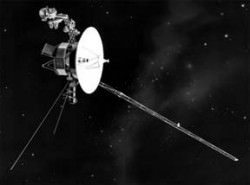 Saturday, August 15, 2009 – On this date in 2006, Voyager 1, the most distant manmade object, reached 100 astronomical units (AUs) from the Sun—meaning 100 times more distant from the Sun than Earth—about 15,000 million kilometers (9,300 million miles). Voyager 1 continues traveling at a rate of about a million miles per day and could cross into interstellar space within 10 years. What fanastic sights do you think it is seeing?
Saturday, August 15, 2009 – On this date in 2006, Voyager 1, the most distant manmade object, reached 100 astronomical units (AUs) from the Sun—meaning 100 times more distant from the Sun than Earth—about 15,000 million kilometers (9,300 million miles). Voyager 1 continues traveling at a rate of about a million miles per day and could cross into interstellar space within 10 years. What fanastic sights do you think it is seeing?
Tonight we’ll head toward the riches of Scorpius to have a look at three pristine open clusters. Begin your starhop at the colorful southern Zeta pair and head north less than 1 degree for NGC 6231 (RA 16 54 08 Dec -41 49 36).
Wonderfully bright in binoculars and well resolved in the telescope, this tight-open cluster was discovered by Hodierna before 1654. De Cheseaux cataloged it as object 9, Lacaille as II.13, Dunlop as 499, Melotte as 153, and Collinder as 315. No matter what catalog number you choose to put in your notes, you’ll find the 3.2-million-year young cluster shining as the ‘‘Northern Jewelbox!’’ For high power fans, look for the brightest star in this group, called van den Bos 1833, a
splendid binary.
About another degree north is the loose open cluster Collinder 316, with its stars scattered widely across the sky. Caught on its eastern edge is another cluster known as Trumpler 24, a site where new variables might be found. This entire region is encased in a faint emission nebula called IC 4628, making this low-power journey through southern Scorpius a red-hot summer treat!
Sunday, August 16, 2009 – Before dawn, look for the close pair of Mars and the Moon celebrating the 1744 birth on this date of Pierre Mechain! We know Mechain as Charles Messier’s assistant, but Mechain was himself a fine astronomer and mathematical prodigy. He discovered 11 comets, and provided 26 entries to Messier’s catalog. If he were alive today, Pierre would be eager to join us tonight for our studies.
Begin about a degree and a half south of twin Nu Scorpii for NGC 6242 (RA 16 55 36 Dec -39 28 00).
Discovered by Lacaille and cataloged as I.4, this object is also known as Dunlop 520, Melotte 155, and Collinder 317. At roughly magnitude 6, this open cluster is within binocular range but truly needs a telescope to appreciate its fainter stars. Although NGC 6242 might seem like nothing more than a pretty little cluster with a bright double star, it contains an X-ray binary that is a ‘‘runaway’’ black hole, surmised to have formed near the galactic center and vaulted into an eccentric orbit when the progenitor star exploded. Its kinetic energy is much like that of a neutron star or a millisecond pulsar, and it was the first black hole confirmed to be in motion.
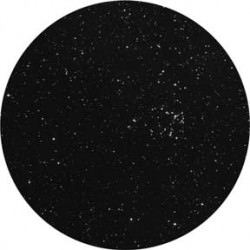 Now head a little more than a degree east-southeast for NGC 6268 (RA 17 02 40 Dec -39 44 18).
Now head a little more than a degree east-southeast for NGC 6268 (RA 17 02 40 Dec -39 44 18).
At a rough magnitude of 9, this small open cluster can be easily observed in smaller scopes and resolved in larger ones. NGC 6268 itself is somewhat lopsided, with more of its members clustered near its western border. Although it, too, might not seem particularly interesting, this young cluster is highly evolved and contains some magnetic, chemically peculiar stars; it has some Be-class, or metal weak, members as well.
Until next week? Keep on yelling when the Perseids fly over! I’m sure St. Lawrence would approve…
This week’s awesome images are (in order of appearance): M25 (credit—Palomar Observatory, courtesy of Caltech), Voyager 1 (credit—NASA), NGC 6231, NGC 6242 and NGC 6268 (credit—Palomar Observatory, courtesy of Caltech). We thank you so much!

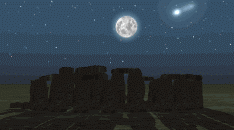
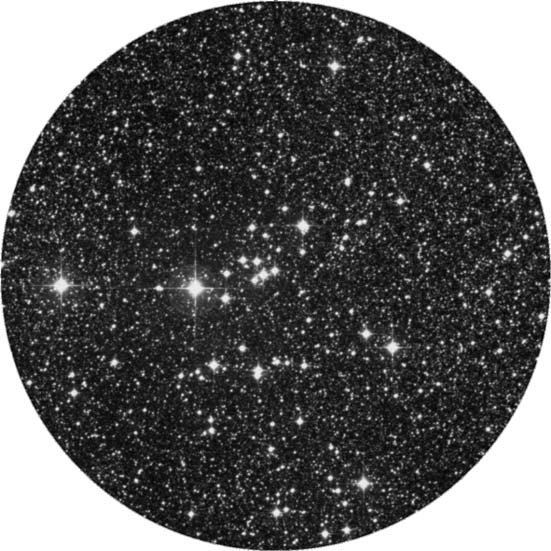

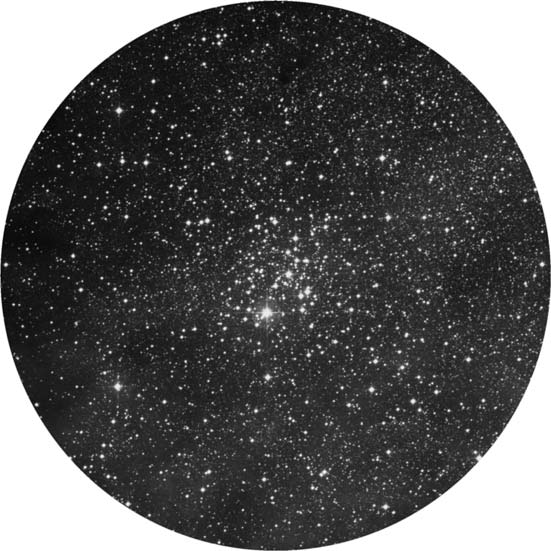
thanks as always